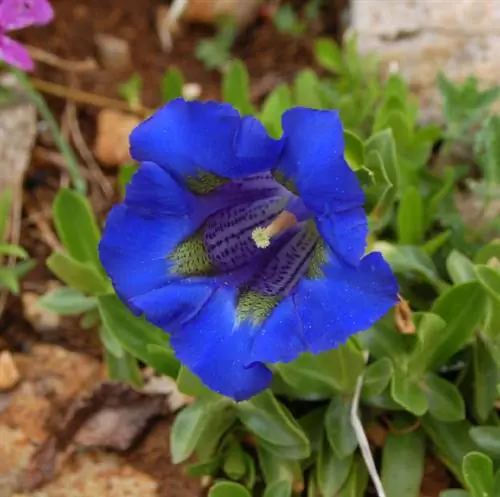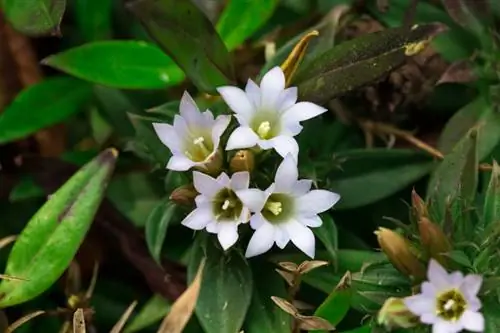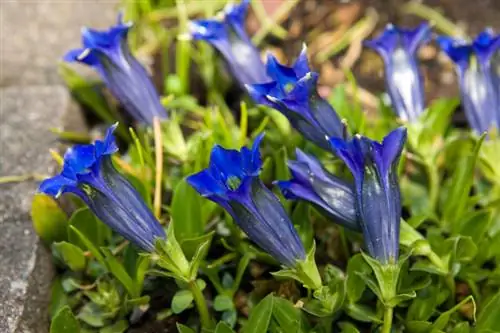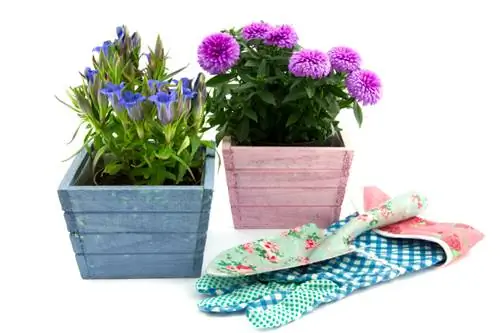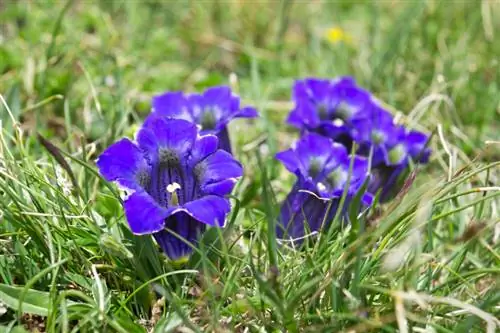- Author admin [email protected].
- Public 2023-12-25 17:45.
- Last modified 2025-01-23 11:22.
Its bright blue, white or yellow flowers set the scene for gentian spectacularly without requiring the gardener to undertake any extensive care. The introduction of this magnificent perennial into the home garden should not fail because of unanswered questions, because you can find the answers here.
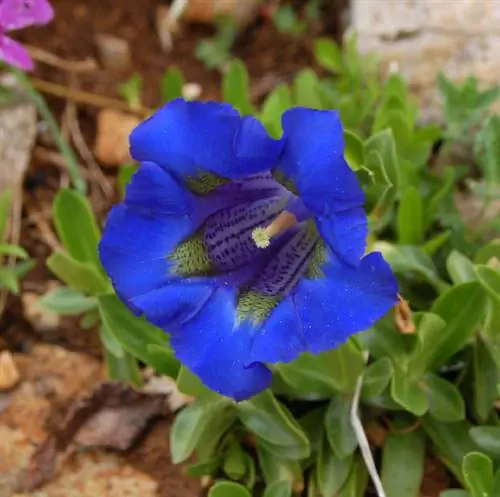
What is the best way to care for gentian?
Gentian thrives best in a sunny to partially shaded location with well-drained, humus-rich soil that is either acidic or calcareous, depending on the species. Simple care includes occasional watering, no fertilizing and removing spent flowers for reblooming as well as winter protection in rough locations or in pots.
Planting gentian correctly
Plant gentian in a sunny to partially shaded location, without bright midday sun. Considering the variety you choose, plant the flower in acidic, humus-rich soil or calcareous, sandy-rocky soil. While you weed and rake the soil, the root ball stands in a container with water. This is how the planting continues:
- Dig pits at a distance of 20-30 cm with 1.5 times the volume of the root ball
- Plant one potted flower at a time up to the bottom pair of leaves
- Press the soil and water with calcareous or soft water - depending on the type of gentian
Optimize the excavation with either a little compost and lime or a handful of ericaceous soil. If you place gentian in the balcony box or bucket, drainage above the floor opening prevents harmful waterlogging. To prevent soil crumbs from clogging the drainage, spread an air- and water-permeable fleece between the clay shards and the substrate.read more
Care tips
If you take the different location requirements of gentian species into account, the flower will be pleasantly frugal in care:
- Water gentian when it is dry without causing waterlogging
- Appropriate to the type, use soft rainwater or calcareous tap water
- Fertilizing is not necessary in humus-rich garden or potting soil
- Cut off wilted flower stems for rebloom
- Cut the leaves close to the ground before winter or in early spring
We recommend winter protection in rough locations and in pots. Before the first frost, cover the cut flower with leaves and brushwood. Planters are covered with foil and placed on wood. It is important to note that if there is a clear frost on mild winter days, water a little.read more
Which location is suitable?
All gentian species are sun-hungry. The flower also thrives in a partially shaded location. Ideally, the perennial is protected from summer heat. However, there are significant differences with regard to the nature of the soil. The Clusius gentian prefers calcareous soil, while Koch's gentian prefers to grow in acidic soil. Therefore, pay special attention to the location requirements when purchasing a young plant.read more
The correct planting distance
Most gentian species and varieties do well with a planting distance of 20 to 30 cm. An exception is the swallowwort gentian, which can grow up to 50 cm high and should preferably be planted in the ground at a distance of 40 cm. The majestic yellow gentian, which stretches 1 meter or higher towards the sky in summer, comes into the ground at a distance of 50-60 cm from its neighbor.
What soil does the plant need?
Gentian prefers nutrient-poor, humus-rich and well-drained soil. However, there are different requirements with regard to soil acidity. The broad genus contains species for both acidic and calcareous soils. The large-flowered summer gentian, for example, is the ideal flower for the lime-rich gravel bed, while the October gentian only thrives in acidic ericaceous soil.
What is the best time to plant?
Planting time for early gentian is all year round, as long as the ground is not frozen. However, avoid planting during summer hot spells in favor of a mild spring day in April or May. Late summer, during the months of August to mid/end of September, is also wisely chosen. In this case, the young plants should receive winter protection in the form of fleece, jute or leaves.
When is flowering time?
If you don't get tired of the pretty gentian flowers at any time of the year, the species-rich plant genus has a suitable flower for you for spring, summer and autumn. Simply combine the species and varieties like this:
- Spring gentian (Gentiana acaulis): May to June
- Summer gentian (Gentiana septemfida var. lagodechiana): July to September
- Autumn gentian (Gentiana sino-ornata): September to November
If you cut off the withered flowers after the first run, numerous gentians will give you another chance to bloom again.read more
Cut gentian correctly
If you cut back the withered flower after the first blooming period, there is the best chance of reblooming in a suitable location. Deciduous gentian is cut back close to the ground before the first frost. Wintergreen species and varieties are allowed to decorate the garden during the cold season, only to be cut off in early spring. If you do not want to sow gentian yourself in the garden, cut off the flower stems in good time before seeds form.read more
Watering gentian
Gentian prefers alternately moist soil both in the bed and in the pot. Only water when the surface has dried and avoid even short-term waterlogging. Adjust the watering water to the type and variety of flower being cared for. Kochscher Gentian would like to be supplied with lime-free water. However, Clusius gentian cannot do without the lime content in the irrigation water. Ideally, you do not water the flower, but rather water directly to the roots.
Fertilize gentian properly
If the substrate meets the requirements, fertilizer can be dispensed with for gentian. Too high a nutrient content could force leaf growth while flowering falls far short of expectations. However, if a lime-loving flower is struggling, administer a dose of vital lime or rock powder.
Wintering
Winter hardiness varies among the more than 400 gentian species. If in doubt, take precautions by cutting back the withered flower before the first frost and covering it with a 10-15 cm high leaf cover and a layer of brushwood or pine fronds. Cover a bucket with bubble wrap and place it on wood in front of the protected south wall of the house. If there is a frost, water the flower on mild days so that the root ball does not dry out.read more
Propagate gentian
To propagate gentian, you can choose from the following 3 methods:
- Dividing the root ball in spring or autumn
- Cut cuttings in summer and let them root in lean substrate
- Sowing the seeds in the bed in autumn
You can optionally grow young gentians by sowing them behind glass. Since it is a cold germinator, stratification is required in this case. You can avoid the procedure by soaking the seeds for 12 hours in 0.1 percent gibberellic acid.read more
How do I transplant correctly?
Cultivated in pots, transplanting every 1-2 years is important for further growth. Changing the location of the Alpine flower in the bed should only be considered in exceptional cases, due to the sensitive roots. How to handle the care issue correctly:
- Repotting gentian in a planter in early spring
- In the new pot, lay out a drainage made of pottery shards under the fresh substrate
- Maintain the previous planting depth if possible and water it
You can plant the flower in the bed either in April or September by digging up the root ball over a large area. Take the opportunity to cut off any bare areas and rotten roots. Again, the flower in the new location should not be deeper into the soil than before.
Gentian in a pot
In a pot or flower box, gentian decorates the sunny balcony from spring to autumn. To ensure that the Alpine flower shows its most beautiful side, when choosing the substrate, pay attention to whether it is a type for calcareous or acidic soil. Regardless, drainage above the water drain is essential. Care is all about the following points:
- Watering when dry with normal tap water or soft rainwater
- No fertilizer required if the flower is repotted into fresh substrate once a year
- Clean out wilted flowers to encourage repeat blooms
- In winter, wrap the pot with foil, cut off the leaves and cover the substrate with leaves
The flower is not suitable as a houseplant and will die on the windowsill within a short time.read more
Gentian doesn't bloom
If a gentian no longer blooms in its usual splendor, do not use fertilizer. They encourage the flower to bloom much more effectively through division and rejuvenation. Dig up the root ball in spring, cut it into at least two halves and replant the segments. First, inspect the root system and cut out any bare pieces with a disinfected knife.
Is gentian poisonous to cats?
Gentian poses no he alth risk to humans. Things look different when it comes to cats. Under no circumstances should you let your kitty nibble on the plant. This is particularly true of the yellow gentian (Gentiana lutea), all parts of which contain bitter substances that are poisonous to cats.
Does the gentian also grow as a shrub?
The only thing the gentian perennial and the gentian bush have in common are the blue flowers. The gentian family forms an independent plant family, while the gentian shrub is assigned to the nightshade family. Apart from the different heights, the most important distinguishing criterion is winter hardiness. While the Alpine flower is hardy, the gentian tree becomes weak at temperatures below 10 degrees Celsius.read more
Beautiful varieties
- Spring gentian (Gentiana acaulis): one of the most grateful varieties with deep blue flowers in May and June and subsequent blooms in autumn
- Summer gentian (Gentiana septemfida): medium blue, large flowers with curved tips from July to September
- White Mountain: white-flowering gentian in September and October with ground cover qualities
- Wreath gentian (Gentiana septemfida var. lagodechiana): versatile hybrid with summer flowers in blue
- Swallowroot gentian (Gentiana asclepiadea): bushy mountain meadow gentian with dark blue flowers in autumn

